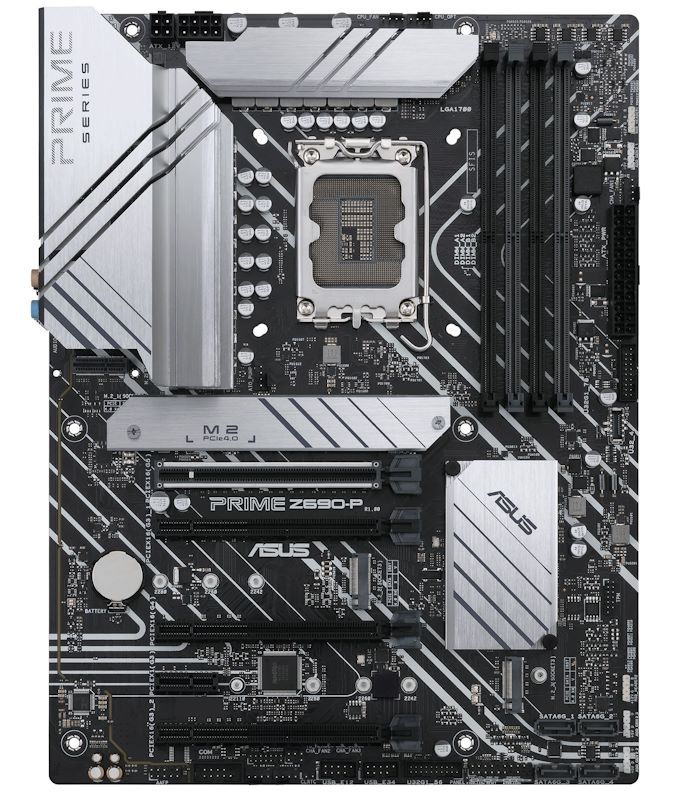The Intel Z690 Motherboard Overview (DDR5): Over 50+ New Models
by Gavin Bonshor on November 9, 2021 9:00 AM ESTASUS Prime Z690-P WIFI (DDR5) & Z690-P (DDR5)
Sitting at the entry-level of the Z690 models from ASUS for the launch of Intel's 12th generation of desktop processors are the ASUS Prime Z690-P WIFI and Prime Z690-P. Both of these models share an identical PCB and aesthetic, with all the same features except one. The Z690-P WIFI includes an Intel Wi-Fi 6 CNVi, while the Z690-P does not. Focusing on the design, the Prime Z690-P WIFI and Z690-P include a black and white patterned PCB, with simplistic silver heatsinks with diagonal lines that fit and match with the rest of the PCB. There is no fancy RGB LED lighting integrated into any section of the board, but ASUS does include three addressable RGB headers and two Aura RGB headers for users to add their own.
Included for PCIe support is a total of five slots that consists of one full-length PCIe 5.0 x16 slot, one full-length PCIe 4.0 x4 slot, two full-length PCIe 3.0 x4 slots, and one smaller PCIe 3.0 x1 slot. For storage, there's three PCIe 4.0 x4 M.2 slots, with one of these supporting SATA drives too. Both the ASUS Prime Z690-P WIFI and Z690-P also include four straight-angled SATA ports that can support RAID 0, 1, 5, and 10 arrays. ASUS has also provided four memory slots that are capable of supporting up to DDR5-6000, with a combined capacity of up to 128 GB.

The ASUS Prime Z690-P (without the Wi-Fi 6 CNVi that the Z690-P WIFI includes)
The only difference between both the Prime Z690-P WIFI and Z690-P is that the WIFI version includes an Intel Wi-Fi 6 CNVi, while the other does not. Everything else is the same, including one USB 3.2 G2x2 Type-C, one USB 3.2 G2 Type-A, two USB 3.2 G1 Type-A, and two USB 2.0 ports. There's also one Realtek RTL8125 2.5 GbE port, a PS/2 combo port, and five 3.5 mm audio jacks and S/PDIF optical output powered by an unspecified Realtek ALC HD audio codec.











126 Comments
View All Comments
Duwelon - Tuesday, November 9, 2021 - link
Asus' prices are completely bananas. If I build a new rig with Z690 it'll probably be my first non-Asus build in a very long time.Sivar - Tuesday, November 9, 2021 - link
That caught my eye, too. I bought an Asus Hero-branded board for my current system last year at approximately $200 USD.I suspect Asus is shifting their marketspeak because the word "Maximus" (used for the z690 board but not mine) usually applies to their most expensive boards.
blppt - Tuesday, November 9, 2021 - link
This. $2000 for a consumer grade motherboard? WTF are they smoking?Also, I'm pretty sure ASUS will be releasing some TUF Z690s at some point, probably at a lower price point than the primes. My experience with the TUF series has been very positive for the price.
DigitalFreak - Tuesday, November 9, 2021 - link
They know they're not going to sell many of those. Those boards are either for LN2 e-peen competitions or people with more money than sense.Wrs - Wednesday, November 10, 2021 - link
TUF is historically just a bit more expensive than Prime. They already have a TUF DDR4 version - ordered the Wifi one for $290 the other day. If worried about price DDR5 is the first mistake.blppt - Wednesday, November 10, 2021 - link
The X570 TUF was cheaper than the X570 Prime when I went shopping for an AMD board.COtech - Tuesday, November 9, 2021 - link
Subtitle - "Intel Z690 Chipset: Like Z590, But Now With Native PCIe 4.0"I think "But Now With Native PCIe 5.0" is intended.
gavbon - Thursday, November 18, 2021 - link
The Z690 chipset doesn't have PCIe 5.0, this comes from the CPU. The Z690 chipset does, however, now include PCIe 4.0 lanes, whereas Z590 did not.Someguyperson - Tuesday, November 9, 2021 - link
I don't get the "DP IN" ports on the ASUS ProArt Z690 Creator WIFI. I see the author just wrote what was on the ASUS website, but that doesn't really explain anything. Are they passthrough to the Thunderbolt out ports? Is there a capture card built into this motherboard? I'm very confused by the labeling here.uwsalt - Tuesday, November 9, 2021 - link
Those are passthrough to the Thunderbolt port. Add-in Thunderbolt cards work the same way. You slot in your discrete GPU, send the output from both DP ports to the Thunderbolt controller, and then use Thunderbolt to output to a Thunderbolt monitor or hub.